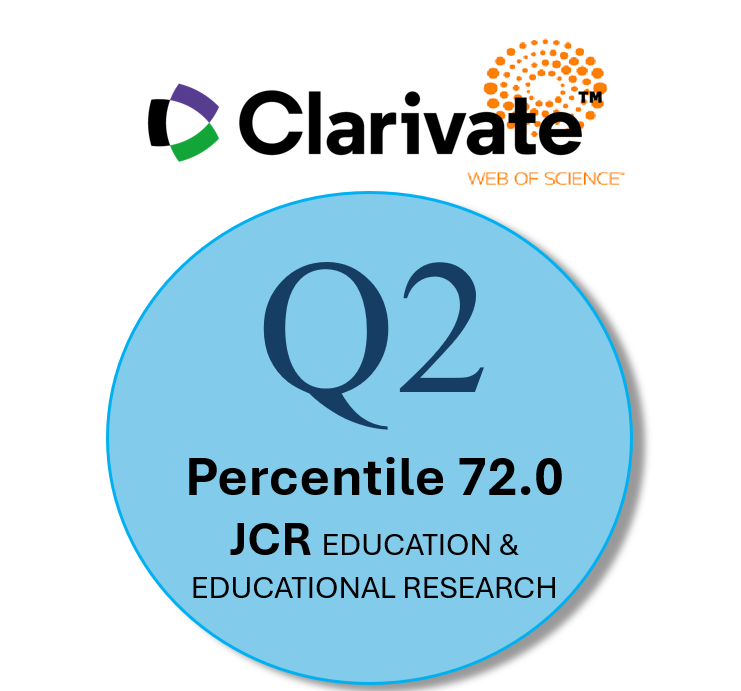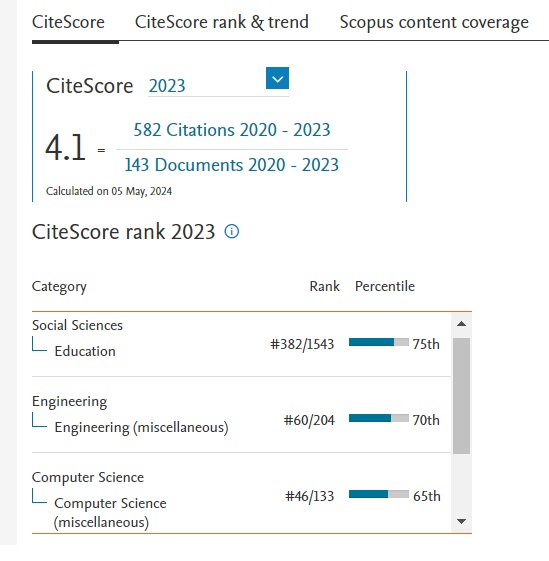Nuevos horizontes en la Educación Sanitaria Especializada: Explorando la plataforma de simulación virtual SIMOONS
Resumen
La simulación virtual está transformando la educación sanitaria especializada al proporcionar un entorno virtual inmersivo y significativo para el desarrollo de habilidades técnicas y no técnicas. Este estudio de caso único investiga la plataforma de simulación virtual SIMOONS en el contexto del entrenamiento de habilidades no técnicas para profesionales sanitarios diversos. Se detallan las funcionalidades de la plataforma, las especificidades didácticas de la simulación virtual y los resultados obtenidos en términos de reacción y percepción del aprendizaje por parte de los participantes del programa eTEAMS, un programa transversal de educación sanitaria especializada centrado en la mejora de las habilidades no técnicas. Los hallazgos muestran que SIMOONS ofrece una alternativa efectiva para recrear entornos virtuales de aprendizaje simulados con pacientes virtuales. Además, los participantes destacan que la simulación virtual brinda un aprendizaje seguro y participativo, equiparable al aprendizaje presencial, permitiendo una retroalimentación efectiva para la transferencia a la práctica clínica.
Descargas
-
Resumen556
-
PDF385
Citas
Alexander, A., Brunye, T., Sidman, J., & Weil, S., (2005). From gaming to training: A review of studies on fidelity, immersion, presence, and buy-in and their effects on transfer in PC-Based simulations and games. DARWARS Training Impact Group.
Asociación Médica Mundial (2015). Declaración de Helsinki. World Medical Association.
Brett-Fleegler, M., Rudolph, J., Eppich, W., Monuteaux, M., Fleegler, E., Cheng, A., & Simon, R. (2012). Debriefing assessment for simulation in healthcare: development and psychometric properties. Simulation Healthcare, 7(5), 288-94. https://doi.org/10.1097/SIH.0b013e3182620228
Buléon, C., Caton, J., Park, Y. S., Eller, S., Buyck, M., Kardong-Edgren, S., Walsh, B. M., Gross, I. T., Maxworthy, J., Reedy, G., & Palaganas, J. C. (2022). The state of distance healthcare simulation during the COVID-19 pandemic: results of an international survey. Advances in simulation, 7(1), 10. https://doi.org/10.1186/s41077-022-00202-7
Calduch, I. (2022). Liminidad y aprendizaje situado en educación superior: una aproximación no lineal y fenomenográfica [Tesis doctoral]. Universidad de Barcelona.
Cant, R., & Cooper, S. (2014). Simulation in the internet age: The place of web-based simulation in nursing education. An integrative review. Nursing Education Today, 34, 1435-1442. https://doi.org/10.1016/j.ne dt.2014.08.001
Cheng, A., Kolbe, M., Grant, V., Eller, S., Hales, R., Symon, B., Griswold, S., & Eppich, W. (2020). A practical guide to virtual debriefings: communities of inquiry perspective. Advances in simulation, 5, 18. https://doi.org/10.1186/s41077-020-00141-1
Dewey, J. (1967). Experiencia y educación. Losada.
Dieckmann, P., Gaba, D., & Rall, M. (2007). Deepening the theoretical foundations of patient simulation as social practice. Simulation Healthcare, 2(3), 183-93. https://doi.org/10.1097/SIH.0b013e3180f637f5
Donohue, L. T., Hoffman, K. R., & Marcin, J. P. (2019). Use of Telemedicine to Improve Neonatal Resuscitation. Children, 6(4), 50. https://doi.org/10.3390/children6040050
Dubovi, I. (2019). Online computer-based clinical simulations: The role of visualizations. Clinical Simulation in Nursing, 33(C), 35-41. https://doi.org/10.1016/j.ecns.2019.04.009
Eppich, W., & Cheng, A. (2015). Promoting excellence and reflective learning in simulation (PEARLS): development and rationale for a blended approach to health care simulation debriefing. Simulation in Healthcare, 10(2), 106-115.
Gaba D. M. (2007). The future vision of simulation in health care. Simulation in Healthcare, 2(2), 126-135. https://doi.org/10.1097/01.SIH.0000258411.38212.32
Geraldine, S., Malcolm, N., & Anthony, S. (2023). Twelve tips for the pre-brief to promote psychological safety in simulation-based education. Medical Teacher, 45(12), 1349-1356. https://doi.org/10.1080/0142159X.2023.221430
Gorbanev, I., Agudelo-Londoño, S., González, R. A., Cortes, A., Pomares, A., Delgadillo, V., Yepes, F. J., & Muñoz, Ó. (2018). A systematic review of serious games in medical education: quality of evidence and pedagogical strategy. Medical education online, 23(1), 1438718. https://doi.org/10.1080/10872981.2018.1438718
Koehler, M. J., Mishra, P., & Cain, W. (2013). What is technological pedagogical content knowledge (TPACK)? Journal of Education, 193(3), 29-37. https://www.jstor.org/stable/24636917
Kolb, D. (1984). Experiential learning: experience as the source of learning and development. Prentice Hall.
Lave, J., & Wenger, E. (1991). Situated learning. Legitimate peripheral participation. Cambridge University.
León-Castelao, E., & Maestre, J.M. (2019). Prebriefing en simulación clínica: análisis del concepto y terminología en castellano. Educación Médica, 20(4), 238-248. https://doi.org/10.1016/j.edumed.2018.12.011
Lioce, L. (Ed.), Lopreiato, J., Downing, D., Chang, T.P., Robertson, J.M., Anderson, M., Diaz, D.A., Spain, A.E., & the Terminology and Concepts Working Group (2020). Healthcare Simulation Dictionary (2º Ed.). Agency for Healthcare Research and Quality. https://doi.org/10.23970/simulationv2
Luctkar-Flude, M., Tyerman, J., Verkuyl, M., & Gumapac, N. (2021). Effectiveness of Debriefing Methods for Virtual Simulation: A Systematic Review. Clinical Simulation in Nursing, 57, 18-30. https://doi.org/10.1016/j.ecns.2021.04.009
McGaghie, W.C., Issenberg, S.B., Petrusa, E.R., & Scalese, R.J. (2019). A critical review of simulation-based medical education research: 2003-2009. Medical Education, 44(1), 50-63. https://doi.org/10.1111/j.1365-2923.2009.03547.x
Palaganas, J., Maxworthy, J., Epps, C., & Mancini, M. (2022). Defining excellence in simulation programs. Wolters Kluwer.
Roussin, C.J., & Weinstock, P. (2017). SimZones: an organizational innovation for simulation programs and centers. Academic Medicine, 92(8), 1114-1120. https://doi.org/10.1097/ACM.0000000000001746
Rudolph, J., Simon, R., & Raemer, D. (2014). Establishing a safe container for learning in simulation. The role of the presimulation briefing. Society for Simulation in Healthcare, 9(6), 339-349. https://doi.org/10.1097/SIH.0000000000000047
Rudolph, J.W., Palaganas, J., Fey, M.K., Onello, R., Thomas, K., & Simon, R. (2016). A DASH to the Top: Educator Debriefing Standards as a Path to Practice Readiness for Nursing Students. Clinical Simulation in Nursing, 12(9), 412-417. https://doi.org/10.1016/j.ecns.2016.05.003
Rudolph, J.W., Simon, R., Rivard, P., Dufresne, R.L., & Raemer, D.B. (2007). Debriefing with good judgment: combining rigorous feedback with genuine inquiry. Anaesthesiology Clinics, 25(2), 361-76. https://doi.org/10.1016/j.anclin.2007.03.007.
Schön, D. (1992). La formación de profesionales reflexivos: hacia un nuevo diseño de la enseñanza y el aprendizaje en las profesiones. Paidós Ibérica.
Shulman, L. S. (1987). Knowledge and teaching: foundations of new reform. Harvard Educational Review, 57(1), 1-22.
Simon, R., Raemer, D.B., & Rudolph, J.W. (2010). Debriefing Assessment for Simulation in Healthcare (DASH)© Rater’s Handbook. Center for Medical Simulation. https://harvardmedsim.org/wp-content/uploads/2017/01/DASH.handbook.2010.Final.Rev.2.pdf
Stake, R.E. (2020). The art of Case Study research (6th Edition). Sage.
Swerdlow, B., Soelberg, J., & Osborne-Smith, L. (2021). Synchronous Screen-Based Simulation in Anesthesia Distance Education. Advances in medical education and practice, 12, 945–956. https://doi.org/10.2147/AMEP.S323569
Derechos de autor 2024 Revista de Educación a Distancia (RED)

Esta obra está bajo una licencia internacional Creative Commons Atribución-NoComercial 4.0.
Las obras que se publican en esta revista están sujetas a los siguientes términos:
1. El Servicio de Publicaciones de la Universidad de Murcia (la editorial) conserva los derechos patrimoniales (copyright) de las obras publicadas, y favorece y permite la reutilización de las mismas bajo la licencia de uso indicada en el punto 2.
2. Las obras se publican en la edición electrónica de la revista bajo una licencia Creative Commons Reconocimiento-NoComercial-SinObraDerivada 3.0 España (texto legal). Se pueden copiar, usar, difundir, transmitir y exponer públicamente, siempre que: i) se cite la autoría y la fuente original de su publicación (revista, editorial y URL de la obra); ii) no se usen para fines comerciales; iii) se mencione la existencia y especificaciones de esta licencia de uso.
3. Condiciones de auto-archivo. Se permite y se anima a los autores a difundir electrónicamente las versiones pre-print (versión antes de ser evaluada) y/o post-print (versión evaluada y aceptada para su publicación) de sus obras antes de su publicación, ya que favorece su circulación y difusión más temprana y con ello un posible aumento en su citación y alcance entre la comunidad académica. Color RoMEO: verde.














